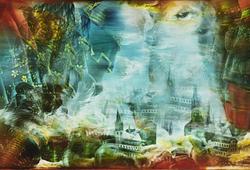John Bauer
"Ut i vida världen" (Sagoprinsen)
Signed B. Oil on canvas 55 x 43 cm.
Alkuperä - Provenienssi
The artist's family.
Stockholms Auktionsverk, Fine Art & Antiques, 14 June 2023, lot 222.
Kirjallisuus
Harald Schiller, "John Bauer the Fairy Tale Illustrator", Stockholm 1942, cf. "Ut i vida världen", watercolour 40 x 40 cm, 1907, original for illustration in the publication "Julbocken 1907", illustrated p. 49.
Muut tiedot
In the catalogue for Waldemarsudde's major exhibition "Trollbunden – John Bauer och den magiska naturen" (2020), the frontispiece is adorned with the watercolour "Ut i vida världen" from 1907.
In this auction, Bukowskis is pleased to present a similar motif, painted in oil on canvas. A young nobleman has paused with his horse and gazes towards the sky. The powerful, robust horse is beautifully adorned with decorative harness, and the curls of its forelock are embellished with green leaf tendrils. The boy's golden sword forms a vertical line that anchors the pair against the horizon. The young boy and the strong white horse are recurring themes in Bauer's fairy-tale world, notably in "A Knight Rode Forth" from 1915 and "The Boy Who Was Never Afraid," 1912.
The line work connects the entire composition, which is evident in the depiction of the outline of the horse, the boy's clothing, and the ornamental details. In the current painting, the paint is so thin that the swirling, rhythmic lines shine through. The author Harald Schiller has described Bauer's fascination with the artist Carl Larsson during his early years at the Royal Academy of Fine Arts. Students at the turn of the century had three role models to relate to: Anders Zorn, Richard Bergh, and Carl Larsson. Schiller writes that Carl Larsson's art captivated Bauer with "irresistible" force. For a couple of years, he was strongly dependent on Larsson – the master of line, which is evident in the work in this auction.
The painting bears a label on the reverse with the title The Fairy Tale Prince, and the motif is closely related – both in composition and colour palette – to Bauer's larger painting "Sagoprinsessan" from 1905. It depicts the art student Ester Ellqvist, who two years later became John Bauer's wife. The portrait is executed on Tjockö in the Stockholm archipelago. Just like in the auction's painting, the artist has placed his main character on a rocky ledge, surrounded by a backdrop of birches. Dressed in a red cloak, with a lily of the valley in her hand, the princess gazes up towards the sky.
John Bauer's breakthrough came in 1907 through his illustrations for the fairy tale collection "Bland Tomtar och Troll", an annual Christmas collection published by Åhlén & Åkerlund in Sweden..
What made Bauer's breakthrough so evident was how he managed to create an entirely new visual language for the Swedish fairy tale tradition. His images combined the mystical and the Nordic: dark forests, heavy trolls, dreamlike princesses, and solitary wanderers. Unlike earlier, more romantic or decorative fairy tale images, Bauer introduced a suggestive, sometimes almost frightening atmosphere – but always with a poetic and human tone. It was with these images that he quickly became one of Sweden's most beloved illustrators.
Taiteilija
John Bauer was born in 1882 and was a Swedish artist, primarily renowned for his paintings and illustrations in the early editions of the fairy tale collection "Bland tomtar och troll”. Thanks to his magical illustrations of princesses, trolls, and giants, Bauer has significantly influenced our perception of creatures and mythical figures in traditional Swedish stories and Nordic folklore.
Bauer grew up in Jönköping, and a large part of his artistry was inspired by the mystical forests of Småland, where trolls and other beings seemed to emerge from the rocky outcrops. During his years of study, he was fascinated by early German and Italian painting but soon returned to the Swedish fairytale forest. At the Royal Swedish Academy of Fine Arts, he met his future wife, Esther Ellqvist, who often posed as a model and served as inspiration for the princess Tuvstarr in Bauer's works.
Most of Bauer's paintings are created using watercolors, although he has also produced some using oil. By the 1910s, thanks to his fairy tale paintings, Bauer was already an established and beloved artist when he chose to conclude his role as a fairy tale illustrator. In his final years, he explored other imaginative expressions that would shape Bauer's last works, such as "The Dancing Nymphs" and "Blue Eva". John Bauer's final significant painting was created for the auditorium at Karlskrona Girls' School in 1917, an oil painting depicting the goddess Freja, with his wife Esther as a model.
The entire Bauer-Ellqvist family died in a boat accident when the steamer Per Brahe sank during an autumn storm on Vättern on November 20, 1918.
















































